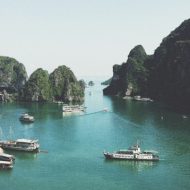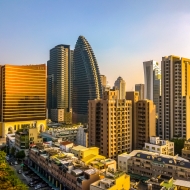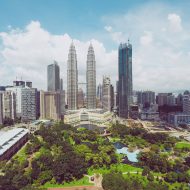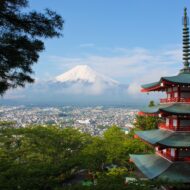
Safest Countries in Asia
Backpackers and travelers’ favorite Asia. Southeast Asia is especially popular among digital nomads and expats. The trends in social platforms or the music hits of some countries in Asia can be some of the reasons to travel there. Likewise, safety can be one of the top concerns when visiting a foreign country as a traveler.
Did you visit the top European countries? Then you must have discovered the beauty of old towns and the Gothic architecture in some cities. You might have as well tried trekking or hiking one of Spain’s beautiful mountains or visiting the Scandinavian country’s snowy streets. If you are an explorer deeply interested in new challenges and excitement, you can aim for longer-distance travel to Asian countries.
In this article, we’ll compile a list of Asia’s top 10 safest countries and explain why you can choose among them. Let’s create a new plan for your new destination and keep your eyes open in your new steps in the world.
What do we cover in this article?
Regions of Asia: Quality of Life
When assessing the quality of life, some measures are the key like life expectancy, education, and the standard of living exist. Asian countries mostly propose a reasonable cost of living, and that’s why many people are attracted to living in a country in Asia. Lower tax rates can also be a motive to move from a European country to Asia.
The Global Peace Index and the Safest Countries
Thanks to the Global Peace Index, we can see the ranks of 163 independent states and territories according to their peacefulness level. While listing the rankings, the Global Peace Index considers domestic and international conflicts that may occur in the nations or that a nation can be involved in.
Top 10 Safest Countries in Asia
Here, you can see the safest Asian countries according to the Global Peace Index.

 10. Mongolia
10. Mongolia
There’s a low crime rate in Mongolia, and the locals are welcoming. Travelers should still be careful in crowded areas and avoid unlicensed taxis. The country has a semi-presidential multi-party representative democracy.
There are some challenges in Mongolia for both the people and the government. A variety of natural hazards occur in the country, such as floods, earthquakes, storms, or extreme winter conditions.

 9. South Korea
9. South Korea
In East Asia, South Korea is in the southern part of the Korean peninsula. It’s a semi-presidential representative democracy, and the country has a unitary system of government. It’s also known for the country's economic development, cultural diversity, and technology. You might have already thought about the pop culture in South Korea and the popularity of K-pop around the world.
A low crime rate, especially against foreigners, a stable political system, and a culture that fosters tolerance and respect among its people make South Korea one of the safest countries in Asia.

 8. Vietnam
8. Vietnam
Vietnam’s Global Peace Index in 2023 is 1.75. In Southeast Asia, Vietnam occupies the eastern part of the Indochinese Peninsula. With a rich culture and natural beauty worth visiting, Vietnam is a relatively safe country for travelers. Still, it’s better to be careful in crowded areas and follow the advice of local authorities.

 7. Kuwait
7. Kuwait
Kuwait is located in the Middle East, a small country at the head of the Persian Gulf. The country is mostly known for its oil wealth and cultural heritage. The Al Sabah family rules the constitutional emirate with a semi-presidential system of government. Although it’s considered relatively safe for travelers with low crime rates, it’s suggested to be aware of potential risks.
There are also environmental challenges in Kuwait, but the government and people work to cope with them and to protect the environment.

 6. Taiwan
6. Taiwan
Taiwan is in East Asia. The country has the main island of Taiwan as well as several smaller islands. Its democracy is led by a president and parliament elected in multiparty elections. Taiwan is relatively safe to visit. However, there is a risk that natural disasters, civil unrest, and cross-strait tensions can appear. Travelers should be careful in crowded areas.

 5. Qatar
5. Qatar
Qatar is a small country in the Middle East. The country has an oil wealth and is known for its strategic location. It’s a constitutional emirate, and the Al Sabah family rules Qatar with a semi-presidential system of government. Qatar is a one-party system; the emir appoints the prime minister, and the cabinet selects the heir-apparent after consulting with the ruling family and other notable figures.
Qatar faces environmental challenges like sand and dust storms, floods, and high temperatures. The government is also working to cope with these challenges.

 4. Malaysia
4. Malaysia
Malaysia is a multi-ethnic and multi-religious federation of 13 states and three federal territories. It’s located in the Southeast Asia. As a country with a low overall crime rate, Malaysia has some areas in the eastern part with a risk of safety. It’s a monarchy, and the head of state is Yang di-Pertuan Agong. The head of government is the prime minister, the leader of the majority party or coalition.

 3. Bhutan
3. Bhutan
Bhutan is in South Asia, located between China and India in the Himalayas. The country has a diverse culture with its cuisine and natural beauty. Although the country is generally safe, there are some natural disasters, such as floods or earthquakes. The government takes some measures to stay safe. Bhutan has been a democracy since 2008 after decades of reforms by the previous king.

 2. Japan
2. Japan
Japan is located in East Asia and is an island country. It’s prone to natural disasters such as earthquakes, tsunamis, or volcanic eruptions. So it’s important to get information from local authorities and hear the instructions. Remember that these rankings may change according to the latest news in these countries.

 1. Singapore
1. Singapore
Singapore is a small island city-state in Southeast Asia. The country has strict laws to enable safety. Singapore’s parliamentary republic has a president as the head of state and, as the head of government, a prime minister. Singapore has many main languages: English, Malay, Mandarin, and Tamil. The diverse country has more than one main religion, and various festivals and holidays are celebrated throughout the year.
Remember that these rankings may change according to the latest information about these countries.
Safest Country: Why is it Important?
As a digital nomad, it’s important to assess the country you will call home in every sense, including safety concerns. When you do that, you can evaluate the democracy, human rights, and political situation in the country you’re moving to.
Moreover, you can see if the legal system protects the residents from possible risks that may threaten your safety. So you know if the crime rate is low or if you’re moving to one of the safest countries. In addition, checking livability, crime and violence, economic reliance, food, and natural resources can be added to your criteria for understanding if a country or a city is safe. Some countries have international conflict, while some have very low crime rates. Other countries may be one of the popular tourist destinations.
Top 20 Safest Cities in Asia
| Rank | City | Country | Safety Index |
| 1 | Abu Dhabi | United Arab Emirates | 88.8 |
| 2 | Doha | Qatar | 85.5 |
| 3 | Taipei | Taiwan | 84.9 |
| 4 | Ajman | United Arab Emirates | 84.5 |
| 5 | Sharajah | United Arab Emirates | 84.1 |
| 6 | Dubai | United Arab Emirates | 83.6 |
| 7 | Eskisehir | Turkey | 81.9 |
| 8 | Muscat | Oman | 79.9 |
| 9 | Hong Kong | Hong Kong (China) | 78.5 |
| 10 | Yeveran | Armenia | 78.1 |
| 11 | Chiang Mai | Thailand | 75.5 |
| 12 | Tokyo | Japan | 75.4 |
| 13 | Seoul | South Korea | 75.3 |
| 14 | Tbilisi | Georgia | 74.1 |
| 15 | Mangalore | India | 73.9 |
| 16 | Riyadh | Saudi Arabia | 73.2 |
| 17 | Tel Aviv-Yafo | Israel | 73.0 |
| 18 | Antalya | Turkey | 72.9 |
| 19 | Davao | Philippines | 72.4 |
| 20 | Jeddah | Saudi Arabia | 71.9 |
Source: Numbeo
The Wrap Up
2023 Global Peace Index (GPI) Report recommends Singapore, Japan, and Malaysia as secure Asian places for digital nomads. These countries excel in sustaining stable political regimes, strong law enforcement, and low levels of violence, making them ideal for remote workers who value safety and stability.
We realize the importance of choosing locations to not only inspire your work but also secure your well-being as digital nomads. The findings of the Global Peace Index are useful in making sensible choices about your future in Asia.
Frequently Asked Questions
Which country in Asia is the safest?
Singapore is the safest country in Asia. This reputation is built on its remarkably low crime rate, efficient law enforcement, and stringent legal system. The city-state also focuses on public safety and security, as evident in its urban planning and social policies.
Which country in Asia is best to live in?
Japan offers a compelling mix of traditional culture and modern convenience. It's an attractive destination to live in Asia. The country has a high standard of living, advanced technology, excellent public transportation, and a strong emphasis on education and healthcare.
Which city in Asia has the lowest crime rate?
Tokyo is Japan's capital city. It's renowned for its low crime rate. This can be because of the strong community ethos, effective policing, and the overall culture of respect and safety that pervades the city.
What are the ten safest countries in the world?
Safest in the world include Iceland, known for its peaceful environment; New Zealand, with its low crime rate; Portugal and Austria, both boasting high safety standards; Denmark and Canada, known for their quality of life; Singapore and Japan in Asia for their strict law enforcement; and the Czech Republic and Switzerland in Europe for their stable political climates.
Which country is No 1 in Asia?
In terms of economic power and global influence, China can be viewed as the leading country in Asia. The country has rapid economic growth, an expanding technological sector, and an increasing international presence.
Which is the cleanest country in Asia?
Singapore is also recognized as the cleanest country in Asia. It maintains cleanliness is attributed to rigorous environmental regulations and effective waste management systems.

 10. Mongolia
10. Mongolia 9. South Korea
9. South Korea 8. Vietnam
8. Vietnam 7. Kuwait
7. Kuwait 6. Taiwan
6. Taiwan 5. Qatar
5. Qatar 4. Malaysia
4. Malaysia  3. Bhutan
3. Bhutan 2. Japan
2. Japan 1. Singapore
1. Singapore![Safest Countries in South America [2024]](https://www.theblogler.com/wp-content/uploads/2023/08/Safest-Countries-in-South-America-610x450.png)


![Safest Countries in the Middle East [2024]](https://www.theblogler.com/wp-content/uploads/2023/03/Safest-Countries-in-the-Middle-East-GVF-Article-Header-Mariam-Soliman-Unsplash-610x450.png)

